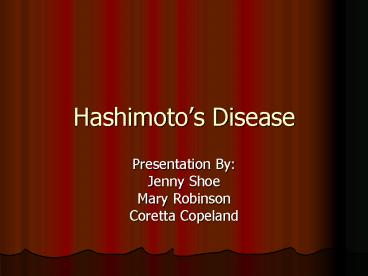Hashimotos Disease - PowerPoint PPT Presentation
1 / 11
Title:
Hashimotos Disease
Description:
Hashimoto's Disease. Presentation By: Jenny Shoe. Mary Robinson. Coretta Copeland ... slow heart rate. weight gain. constipation. intolerance to cold ... – PowerPoint PPT presentation
Number of Views:246
Avg rating:3.0/5.0
Title: Hashimotos Disease
1
Hashimotos Disease
- Presentation By
- Jenny Shoe
- Mary Robinson
- Coretta Copeland
2
Hashimotos Disease or Chronic Thyroiditis
- Is an inflammation of the thyroid gland that
frequently results in hypothyroidism (lowered
thyroid function).
3
(No Transcript)
4
- Hashimotos Disease is a common thyroid gland
disorder that can occur at any age, but it is
most often seen in middle age women. It is
caused by a reaction of the immune system against
the thyroid gland.
5
Early Symptoms
- The onset of the disease is slow, and it may take
months or years for the disease to be detected.
6
Late Symptoms
- Feeling of fullness or tightness in the throat.
- Have trouble swallowing food or liquids.
- Have swelling in the front of neck.
- Some experience
- tiredness
- forgetfulness
- depression
- coarse dry skin
- slow heart rate
- weight gain
- constipation
- intolerance to cold
7
Additional Symptoms
- Hair loss
- Facial swelling
- Joint stiffness
8
Lab Work
- There are several tests available to detect
Hashimotos Disease. - T3 Test
- T3 Test
- Serum Test
9
Testing For Hashimotos Disease
- T4 (Thyroxine)
- T3 (Triiodothyronine)
- Thyroid function is complex, and depends on the
action of many different hormones. - Some hormones, such as T3 and T4 are active
hormones and directly affect the way the body
functions.
10
Additional Test
- Serum TSH (Thyroid Stimulating Hormones or
Thyrotropin) - this test measures the amount of the hormone TSH
in the blood. - TRH, a hormone produced in the hypothalamus,
stimulates the pituitary gland to release TSH. - TSH subsequently stimulates the thyroid hormones,
T3 and T4. - These hormones feedback to the hypothalamus and
pituitary to regulate the release of both TRH and
TSH. - This regulation pathway is altered leading to
under-or over-production of thyroid hormone.
11
Prognosis
- The outcome is usually very good because the
disease remains stable for years or progresses
slowly to a condition of thyroid hormone
deficiency (hypothyroidism) that can be treated
with thyroid replacement therapy.

